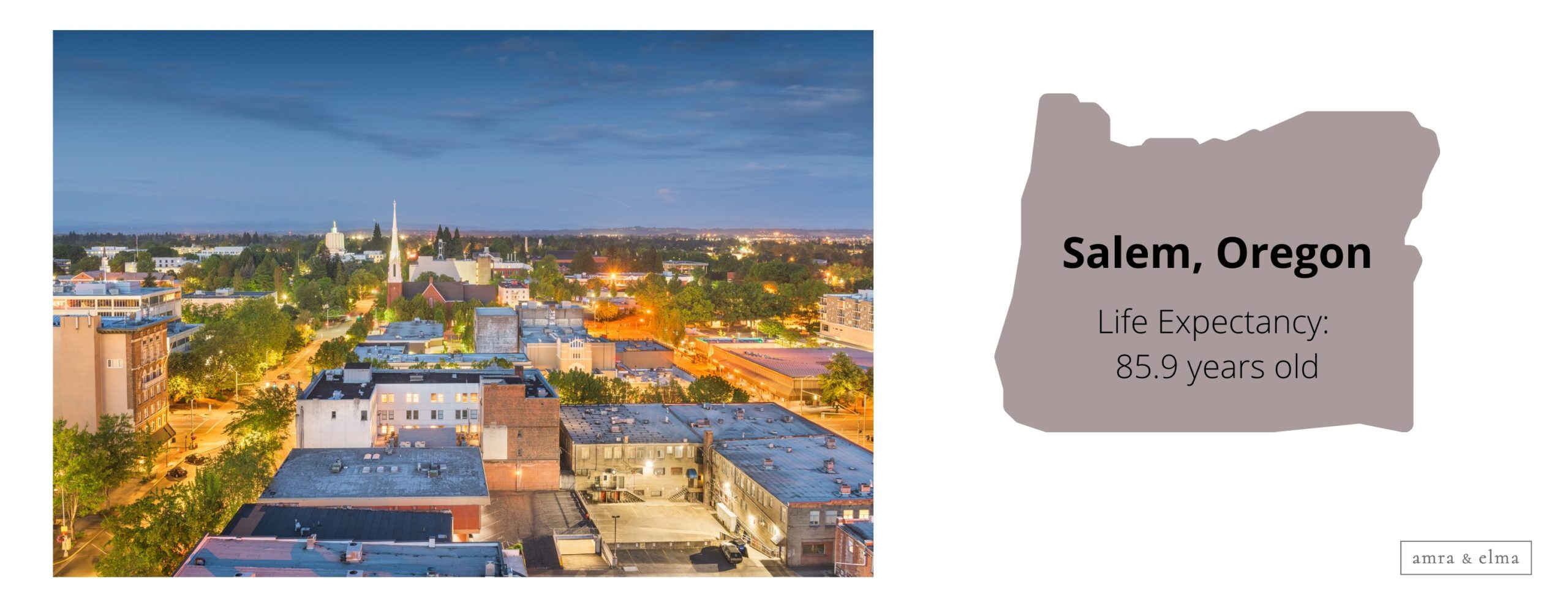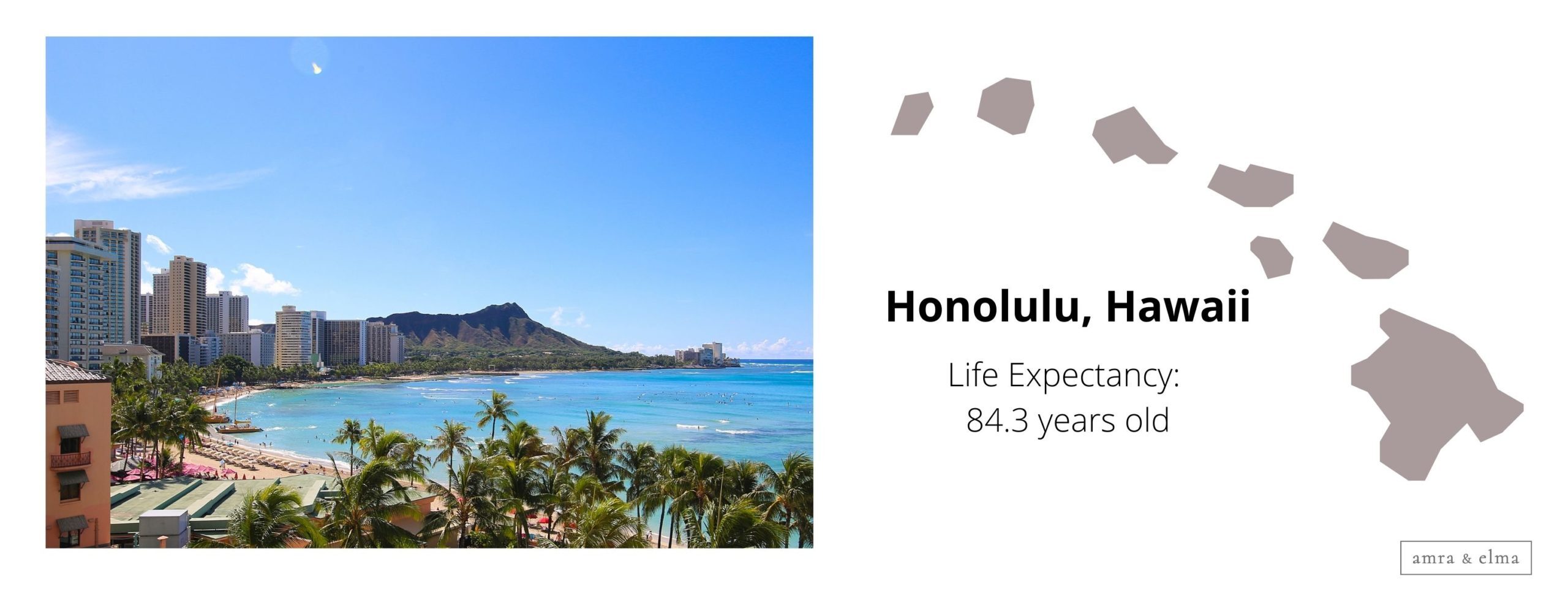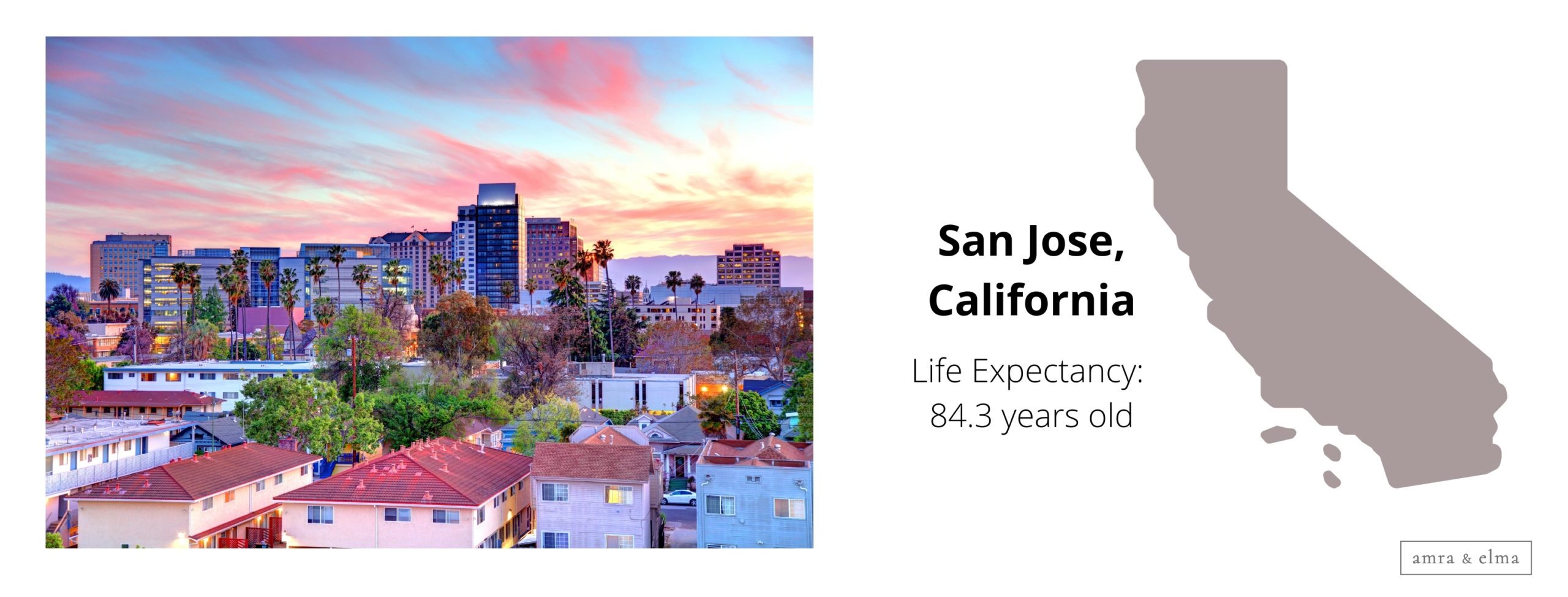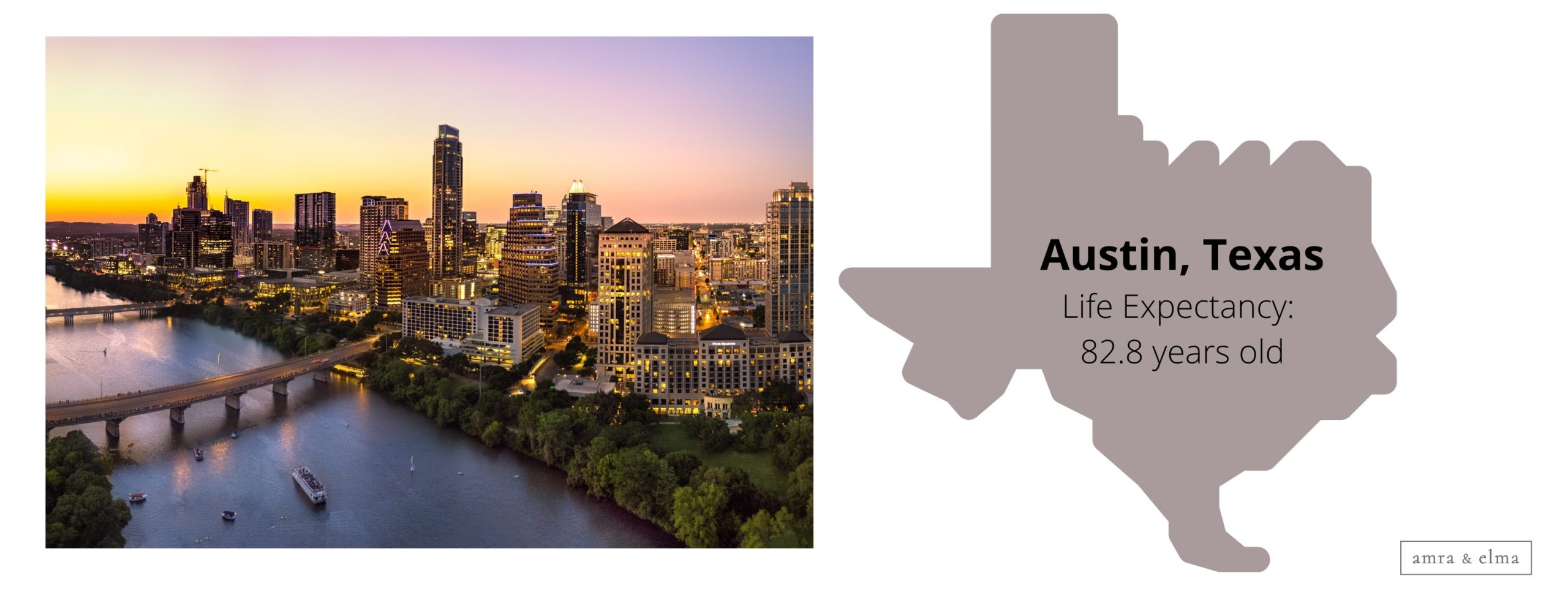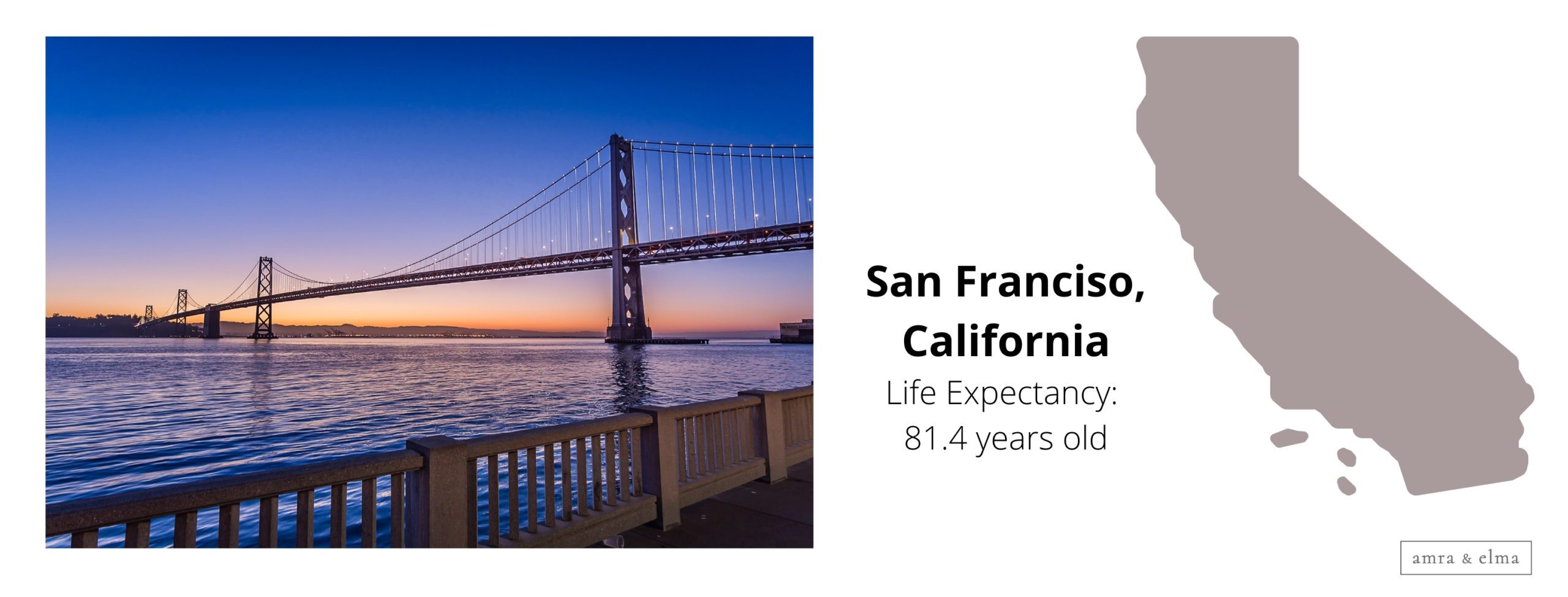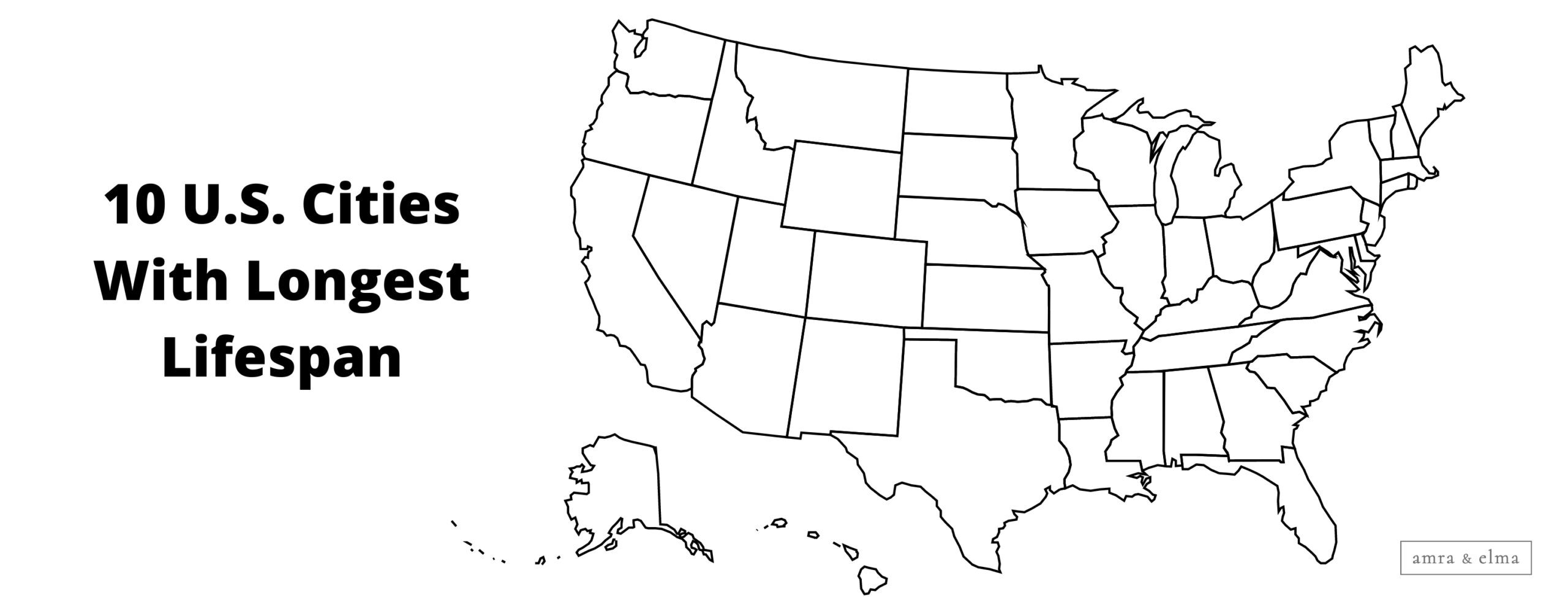
06 Sep U.S. Cities with Longest Life Expectancies in 2024 (Updated)
Several factors contribute to overall health, including living an active lifestyle, eating nutritious foods and maintaining a healthy body weight. Where you live seems to play a role as well. Researchers at Amra & Elma analyzed the latest data from Washington Post, CNN, and Oregonian to find 10 U.S. cities with longest life expectancies in 2024.
10 U.S. Cities with Longest Life Expectancies [2024 Edition]
In the pursuit of understanding the factors influencing longevity in the United States, it becomes evident that certain cities go beyond merely boasting lower rates of obesity and heart disease. Recent research delves into the myriad factors shaping life expectancy, revealing intriguing correlations with climate, population density, and geographical location. According to studies such as those conducted by the Centers for Disease Control and Prevention (CDC), certain cities with lower rates of non-communicable diseases such as obesity and heart disease tend to have longer life expectancies. However, a deeper investigation uncovers additional attributes that contribute to the exceptional longevity observed in these cities.
Recently, 10 U.S. cities were found to have special attributes that may be contributing to the wellness of their residents. For instance, cities like Salem, Oregon, renowned for its lush green landscape and extensive urban trail system, boast high concentrations of parks and outdoor recreational activities. These findings are highlighted in sources such as 10 Great Urban Trails In The U.S.A. and The Oregonian. Similarly, cities with warm climates, such as those on the West Coast or in the Sun Belt region, may offer year-round opportunities for outdoor exercise and socialization, contributing to improved health outcomes. Moreover, cities with low crime rates, easy access to hospitals, and a large number of nearby universities provide residents with comprehensive healthcare services and opportunities for lifelong learning, both of which are associated with increased life expectancy. Additionally, cities with low poverty rates and a high number of psychologists may offer residents greater socioeconomic stability and access to mental healthcare, factors that contribute to overall well-being and longevity. Furthermore, cities with a diverse and vibrant culinary scene, characterized by a large number of local restaurants offering healthy dining options, may promote healthier eating habits among residents, further enhancing their longevity. Unraveling the secrets behind the exceptional longevity in these cities sheds light on the complex interplay between environmental, social, and lifestyle factors in shaping the health outcomes of their residents.
Life Expectancy by Zip Code
The U.S. Small-Area Life Expectancy Estimates Project (USALEEP) has revolutionized the way citizens assess the healthiest areas in the United States by tracking life expectancy by zip code. This innovative initiative provides unprecedented insights into regional health disparities, allowing individuals to make informed decisions about their well-being. For instance, in Salem, Oregon, zip code 97301 exhibits a life expectancy of 79.7 years while the life expectancy in other zip codes in Salem is 85.9 years old, as reported by the U.S. Small-Area Life Expectancy Estimates Project (USALEEP). This data tool, spanning the period 2010-2015, offers a comprehensive snapshot of health outcomes at the local level, empowering communities to address differences and consider various zip codes as potentially healthier than others.
USALEEP, a collaborative effort involving the National Center for Health Statistics, the Robert Wood Johnson Foundation (RWJF), and the National Association for Public Health Statistics and Information Systems (NAPHSIS), represents a significant milestone in public health research and data analysis. By providing estimates of life expectancy at birth for most census tracts in the United States, USALEEP equips local health departments and policymakers with valuable tools to identify areas of concern and prioritize resources accordingly. This wealth of information serves as a catalyst for community engagement and evidence-based decision-making, fostering a culture of health and equity across the nation.
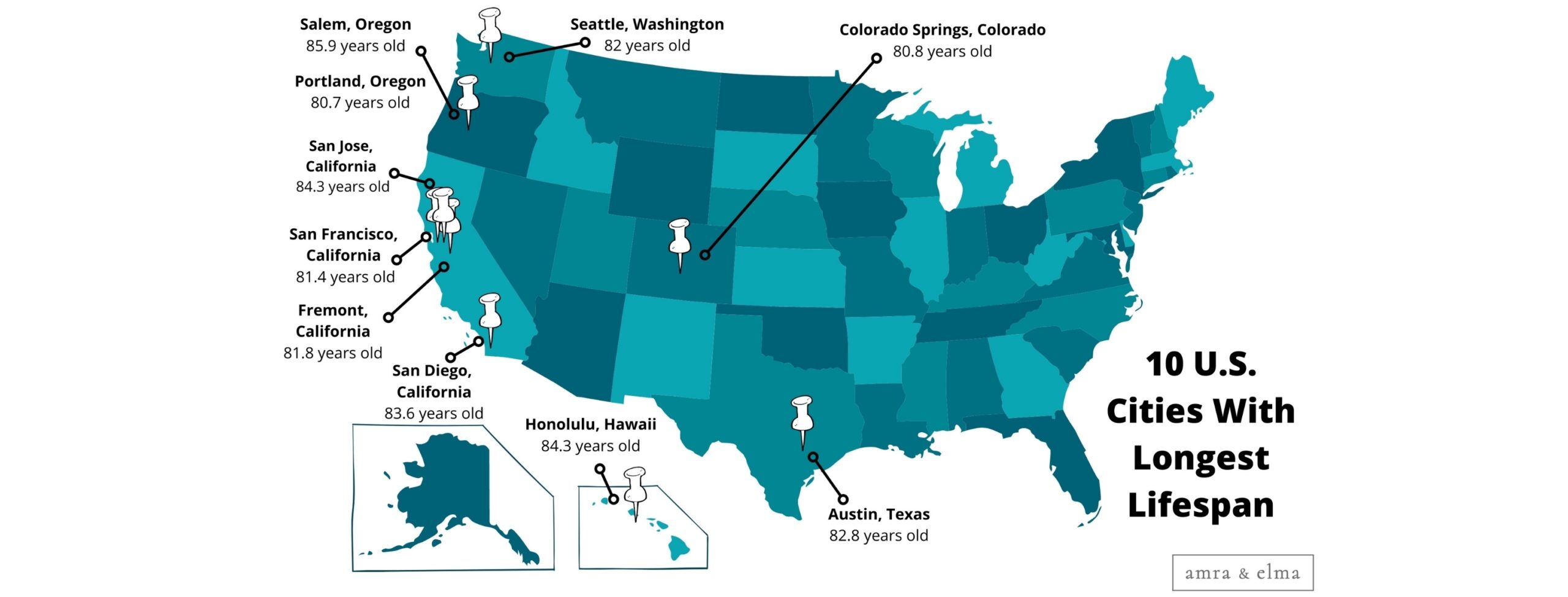
Here are 10 U.S. cities with longest life expectancies in 2024:
1. Salem, Oregon – Life Expectancy by Zip Code – 85.9 years old [Oregonian]
Salem, Oregon’s reputation for its lush greenery and abundance of parks, coupled with its extensive urban trail system spanning 9 miles along the picturesque Willamette River, provides residents with ample opportunities for outdoor recreation and physical activity [Source: 10 Great Urban Trails In The U.S.A.]. The city’s slogan, “where you can play,” aptly captures the ethos of embracing outdoor activities, including bicycling, which contributes to the overall health and well-being of its residents. The Oregonian highlights how these outdoor pursuits may play a significant role in Salem’s unusually long lifespan, indicating a correlation between engagement in outdoor activities and increased longevity.
Furthermore, Salem’s high population density, which is 60% higher than the national average, translates to more opportunities for exercise and socialization among residents [Source: The Oregonian]. With more people per square mile, there are increased chances for community engagement, group fitness activities, and recreational sports, fostering a culture of physical activity and social connectivity. Research consistently demonstrates the health benefits of regular exercise and social interaction, ranging from reduced risk of chronic diseases to improved mental well-being and longevity. Thus, Salem’s conducive environment for outdoor recreation, coupled with its dense population, creates a synergistic effect that promotes healthier lifestyles and potentially contributes to the city’s longer life expectancy compared to national averages.
Moreover, the presence of parks and green spaces in urban environments has been linked to numerous health benefits, including stress reduction, improved mood, and enhanced overall quality of life. Studies have shown that access to green spaces encourages physical activity, reduces sedentary behavior, and fosters a sense of community cohesion. Salem’s commitment to preserving its natural landscape and promoting outdoor recreation aligns with broader public health goals aimed at creating environments that support healthy behaviors and improve population health outcomes. By leveraging its natural assets and fostering a culture of active living, Salem sets an example for other communities striving to enhance the health and well-being of their residents.
2. Honolulu, Hawaii – Life Expectancy by Zip Code – 84.3 years old [CNN]
Honolulu, renowned for its beautiful, sunny beaches and warm climate, stands out as a haven where residents thrive, boasting an impressive life expectancy of 84.3 years. The city’s idyllic setting not only promotes an active lifestyle but also fosters a sense of well-being conducive to longevity. With abundant opportunities for outdoor activities, from swimming to hiking, Honolulu residents are encouraged to stay physically active, a lifestyle linked to improved health outcomes and increased life expectancy. Moreover, Honolulu residents exhibit higher education rates than the national average, affording them better access to job opportunities that offer health benefits and other essential living necessities. According to data from the U.S. Census Bureau, Honolulu’s population demonstrates higher levels of educational attainment compared to the national average, with a significant proportion holding bachelor’s degrees or higher. This educational advantage not only enhances economic opportunities but also translates into better health literacy and informed decision-making regarding healthcare utilization and preventive measures.
Furthermore, Honolulu’s healthcare landscape further contributes to its residents’ longevity, with the city being home to the 10th best hospital in the country, as recognized by various healthcare rankings. The presence of world-class medical facilities not only ensures access to advanced treatments and specialized care but also fosters a culture of medical innovation and research. This environment of excellence in healthcare is complemented by the availability of routine check-ups and preventive screenings offered by Honolulu’s hospitals, facilitating early detection and management of diseases. With easy access to preventive healthcare services, residents can proactively address health concerns and adopt preventive measures, ultimately contributing to the city’s high life expectancy. Honolulu’s status as a healthcare hub underscores its commitment to prioritizing population health and well-being, setting a precedent for other cities aspiring to promote longevity and quality of life among their residents.
3. San Jose, California – Life Expectancy by Zip Code – 84.3 years old [CNN]
San Jose, California, stands out as a city where residents enjoy an impressive life expectancy of 84.3 years, a testament to the favorable living conditions and community attributes that contribute to overall well-being. With a higher than average number of people per square mile, San Jose boasts a vibrant and bustling urban environment that fosters social connectivity and community engagement. This dense population density not only promotes opportunities for interaction and socialization but also facilitates access to amenities and services that support health and quality of life. According to data from the U.S. Census Bureau, San Jose’s population density surpasses the national average, reflecting a dynamic urban landscape that promotes vitality and resilience among its residents.
Moreover, San Jose has earned the distinction of being the safest major U.S. metro area for ten consecutive years, as reported by various crime statistics and safety rankings. This accolade underscores the city’s commitment to public safety and community well-being, creating a secure and conducive environment for residents to thrive. The prevalence of safe neighborhoods and low crime rates not only instills a sense of security but also fosters peace of mind, enabling residents to lead active and fulfilling lives. Additionally, San Jose boasts an above-average proportion of residents who regard their city as the “best place to live,” reflecting a strong sense of community pride and satisfaction with local amenities and quality of life.
San Jose’s enviable climate, characterized by mild temperatures and abundant sunshine, further contributes to its residents’ longevity and well-being. With average summer highs in the upper 70s, San Jose offers ideal conditions for outdoor recreation and leisure activities year-round. The city’s beautiful landscape and great weather encourage residents to enjoy outdoor pursuits such as picnics, barbecues, and recreational sports, promoting physical activity and social engagement. Furthermore, San Jose’s high home values and low crime rates reflect its status as an affluent and secure community, where residents have access to resources and opportunities conducive to healthy lifestyles. This combination of favorable environmental factors, community safety, and economic stability positions San Jose as a model city for promoting longevity and quality of life among its residents.
4. San Diego, California – Life Expectancy by Zip Code – 83.6 years old [Washington Post]
San Diego, renowned for its dreamy beaches and sun-kissed weather, emerges as a beacon of health and vitality, boasting an impressive average life expectancy of 83.6 years. The city’s picturesque landscapes, combined with a low poverty rate, create a conducive environment for residents to thrive and lead fulfilling lives. With its abundance of natural beauty and economic stability, San Diego cultivates a sense of well-being that contributes to the overall health and longevity of its population. According to data from the U.S. Census Bureau, San Diego maintains a lower poverty rate compared to national averages, providing residents with greater access to resources and opportunities for health-promoting behaviors.
Moreover, San Diego’s healthcare infrastructure further enhances residents’ quality of life, with 10 hospitals located within a 10-mile radius and convenient access to hospital parking. This accessibility ensures that residents have ready access to medical equipment, cutting-edge research facilities, and top-tier healthcare professionals. The presence of renowned hospitals and healthcare institutions underscores San Diego’s commitment to prioritizing the health and well-being of its residents, offering comprehensive healthcare services and advanced treatment options.
San Diego’s year-round warm temperatures and abundant sunshine also play a significant role in shaping its high life expectancy. The city’s climate, characterized by clear skies and mild temperatures, fosters an outdoor-centric lifestyle that promotes physical activity and social engagement. According to meteorological data, San Diego boasts more sunny days than popular sun destinations such as Miami or Honolulu, with an average of 10 hours of sunshine per day. This abundance of sunshine provides ample opportunities for residents to enjoy outdoor activities, from beach outings to hiking and cycling, contributing to improved physical and mental well-being. San Diego’s sunny disposition, combined with its natural beauty and healthcare resources, solidifies its reputation as a city where residents thrive and flourish, embracing life to the fullest.
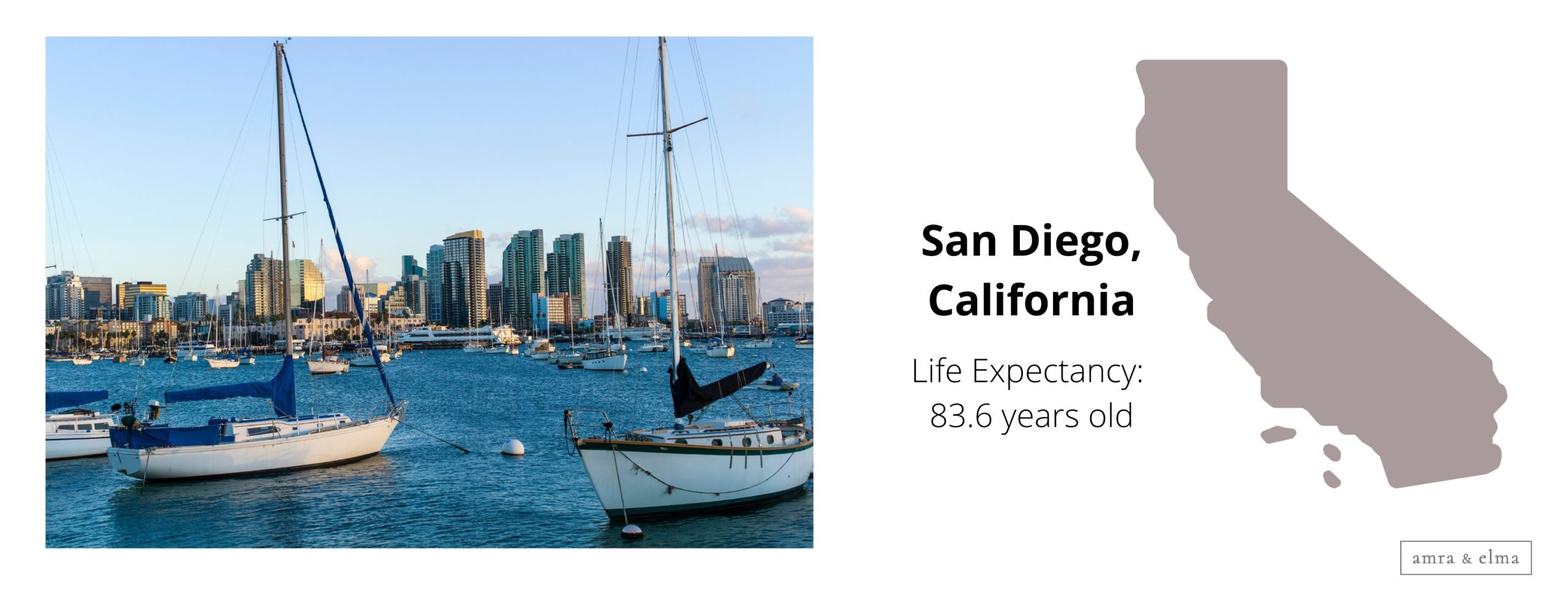
5. Austin, Texas – 82.8 years old* – Life Expectancy by Zip Code [Washington Post]
Austin, Texas, emerges as a city where residents enjoy an average life expectancy of 82.8 years, reflecting a combination of factors that promote health and well-being. Notably, Austin has garnered recognition as the “most educated” city by Forbes, with a wealth of educational opportunities provided by its 10 colleges and universities within a 10-mile radius, including the prestigious University of Texas at Austin. This abundance of educational institutions not only fosters a culture of lifelong learning but also generates numerous job opportunities for residents, many of which offer health benefits that support overall well-being. According to data from the U.S. Census Bureau, Austin’s robust educational infrastructure contributes to its residents’ economic prosperity and access to resources essential for maintaining a healthy lifestyle.
Furthermore, Austin’s above-average population density and reputation as one of the 10 healthiest cities in the U.S. play significant roles in shaping its high life expectancy. The city’s bustling urban environment promotes frequent social interaction and community engagement, fostering a sense of belonging and support among residents. With opportunities for socialization and collaboration readily available, Austin residents are encouraged to lead active lifestyles and prioritize their health. Additionally, Austin’s status as one of the healthiest cities in the nation suggests that residents are likely to have access to healthy foods and engage in regular physical activity as part of their daily routines. This commitment to health and wellness, coupled with a strong sense of community and access to educational and economic opportunities, contributes to Austin’s reputation as a city where residents thrive and enjoy long, fulfilling lives.
6. Seattle, Washington – 82 years old – Life Expectancy by Zip Code [Washington Post]
Seattle, Washington, emerges as a city where residents enjoy a high life expectancy of 82 years, a reflection of the favorable living conditions and community attributes that promote health and longevity. With 10 hospitals conveniently located within a 10-mile radius, Seattle residents have better access to regular medical examinations and healthcare services, contributing to improved health outcomes and overall well-being. This accessibility to healthcare facilities ensures timely screenings, early detection of illnesses, and prompt medical interventions, all of which are crucial factors in extending life expectancy.
Moreover, Seattle’s reputation as having one of the 10 best climates in America further enhances its residents’ quality of life and contributes to their longevity. The city’s mild temperatures and abundant natural beauty create an ideal environment for outdoor activities year-round. With ample opportunities for hiking, biking, and enjoying scenic vistas, Seattle residents are encouraged to lead active lifestyles that promote physical health and mental well-being. The city’s commitment to environmental sustainability and outdoor recreation underscores its dedication to fostering a healthy and vibrant community.
Seattle’s relative affordability, combined with its high home values and low poverty rates, also plays a significant role in shaping its high life expectancy. Despite being a metropolitan area, Seattle maintains a thriving culinary scene, boasting 10 times the national average of restaurants per 10,000 people. This abundance of dining options allows residents to enjoy evenings out on date nights or family dinners without necessarily breaking the bank, promoting social connectivity and enhancing overall quality of life. While Seattle may not be free of stress or crime, its emphasis on community engagement, access to healthcare, and affordability contribute to its reputation as a city where residents can live long, fulfilling lives.
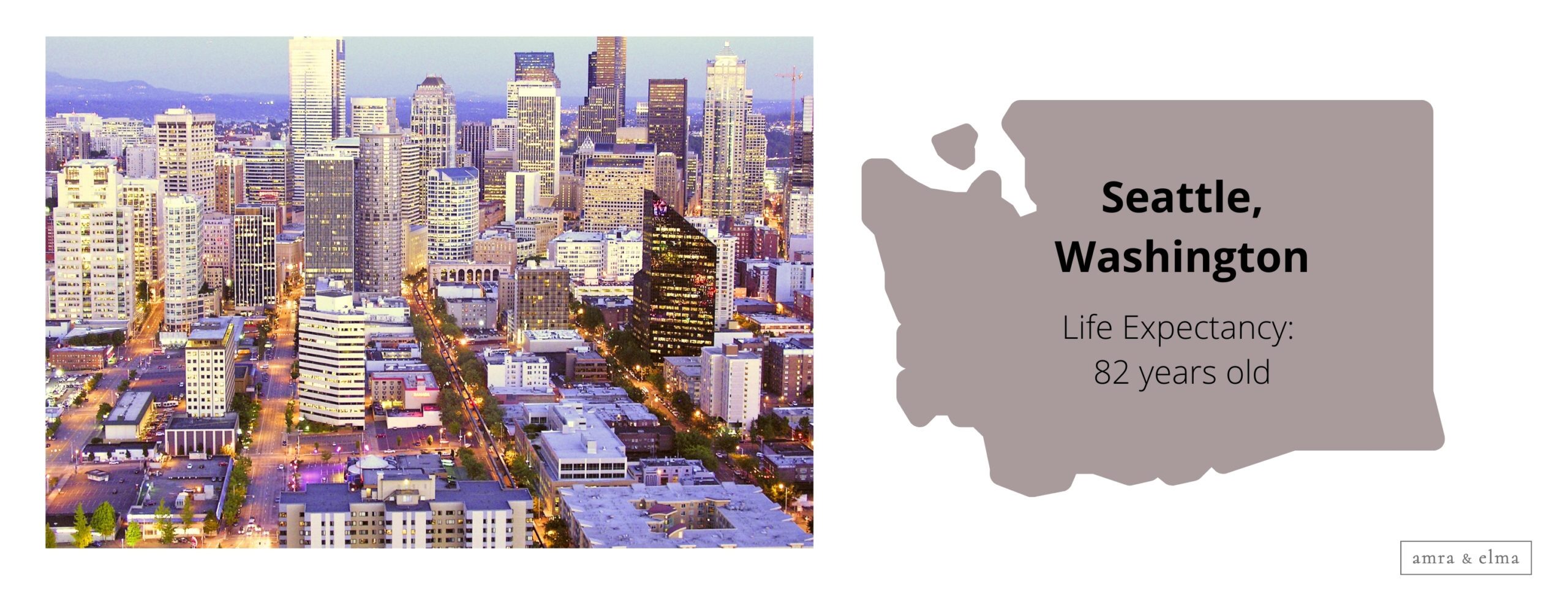
7. Fremont, California – 81.8 years old – Life Expectancy by Zip Code [Washington Post]
Fremont, California has 10 hospitals within 10 miles and one of the 10 best climates in America. These factors may contribute to its average life expectancy of 81.8 years old . Fremont also has 10 times the national average of restaurants per 10,000 people, which means residents have plenty of options for socializing that won’t cost them an arm and a leg.
Fremont’s 10 colleges and universities within 10 miles may also contribute to its high life expectancy. Fremont is home to many tech companies, including Tesla Motors , which attracts residents with above average salaries . All these factors combined could be responsible for Fremont’s 10 times the national average of hospital beds per 10,000 people.
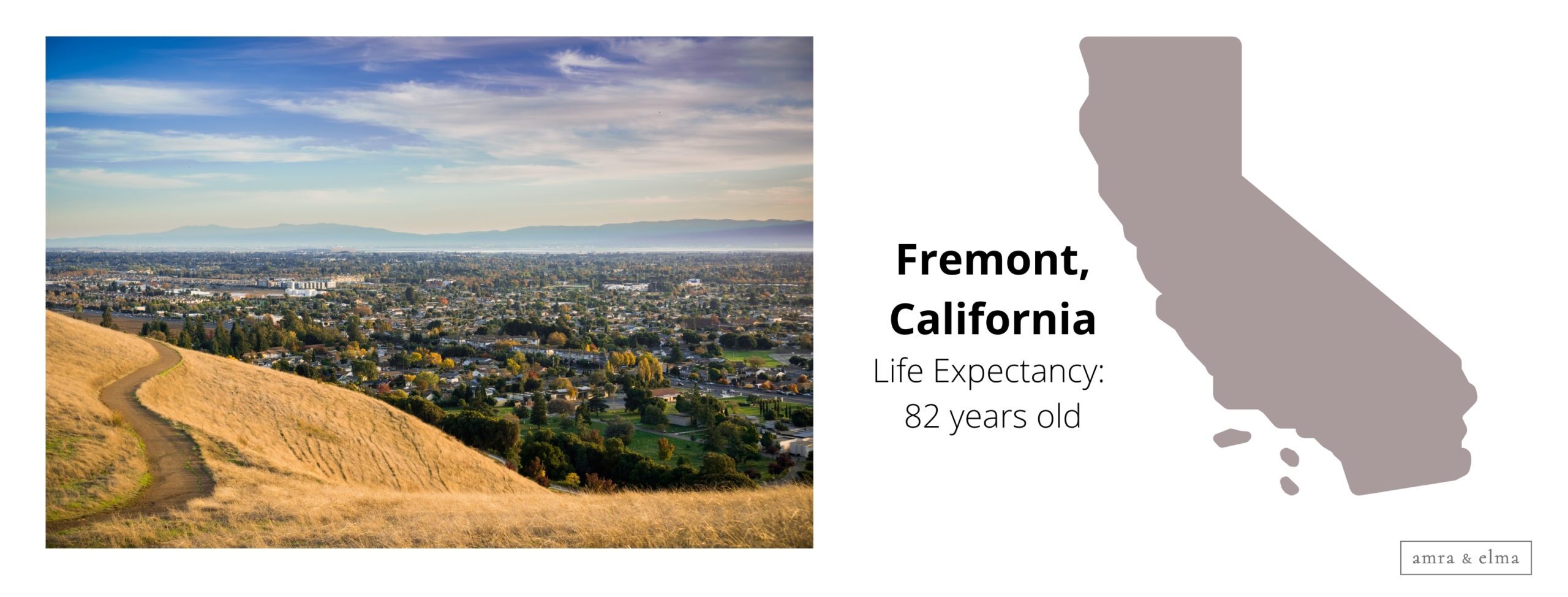
8. San Francisco, California – 81.4 years old – Life Expectancy by Zip Code [Washington Post]
San Francisco, California has 10 universities and 10 hospitals within 10 miles, and this may contribute to its life expectancy of 81.4 years old . Additionally, San Francisco has 10 times the national average of psychiatrists per 10,000 people , which means that residents have access to doctors who specialize in mental health fields. The availability of these services means that residents can more readily seek help for issues related to stress or anxiety.
9. Colorado Springs, Colorado – 80.9 years old – Life Expectancy by Zip Code [Washington Post]
Colorado Springs, Colorado has 10 colleges and universities within 10 miles , which may result to an increased chance for its residence to earn good jobs with high paying positions. This could contribute to the city’s average life expectancy of 80.8 years old . Additionally, it is one of 10 healthiest cities in the U.S , so its residents are likely to be eating healthy meals and engaging in regular physical activity.
Colorado Spring’s 10 times the national average of psychologists per 10,000 people may also extend its residents’ lifespans. The city has 10 health care facilities within 10 miles , which means that it is likely easy for residents to access preventative medical services throughout their lives.
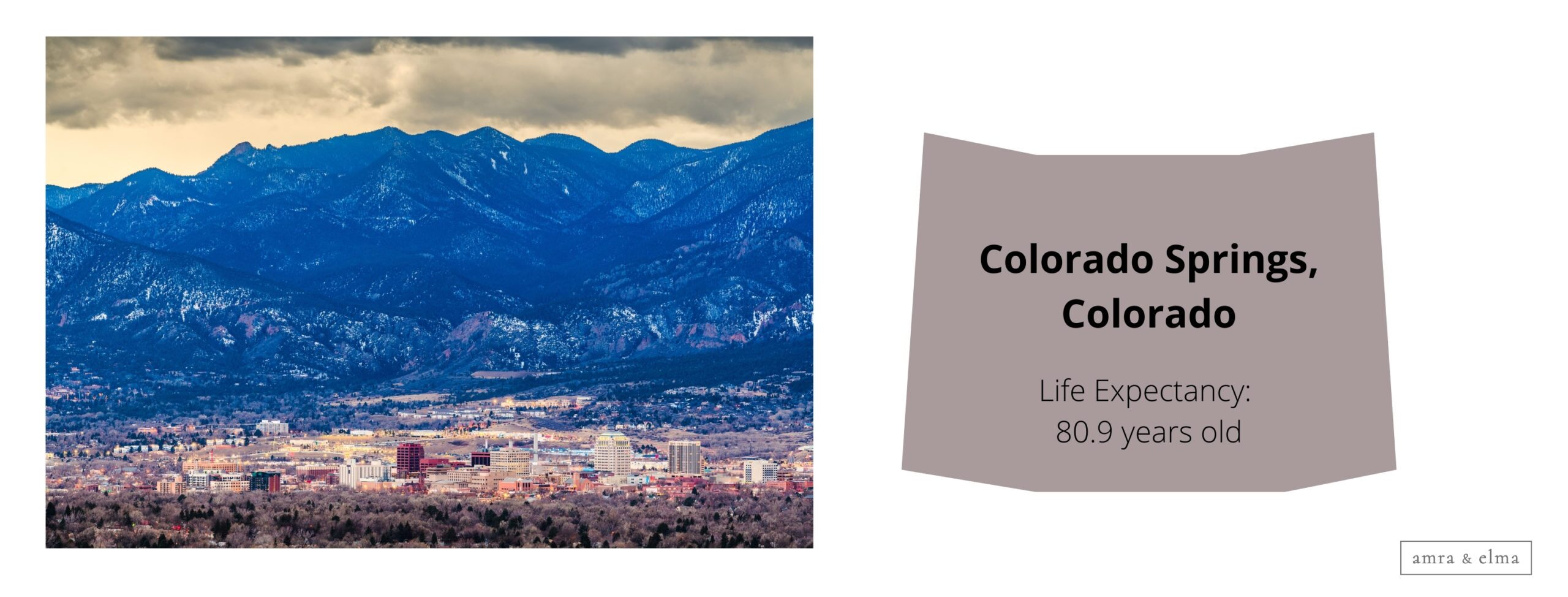
10. Portland, Oregon – 80.7 years old – Life Expectancy by Zip Code [Washington Post]
Aside from living in a state with low air pollution, clean water, and good traffic conditions , Portland’s residents have an average life expectancy of 10 years longer than the rest of Oregon.
Portland is one out of 10 cities that has a higher than average population density at 5 ,491.7 people per square mile , meaning more opportunities for healthy socialization and exercise. Additionally, 10 out of 10 states with the highest average income levels in the United States are located in the Pacific Northwest
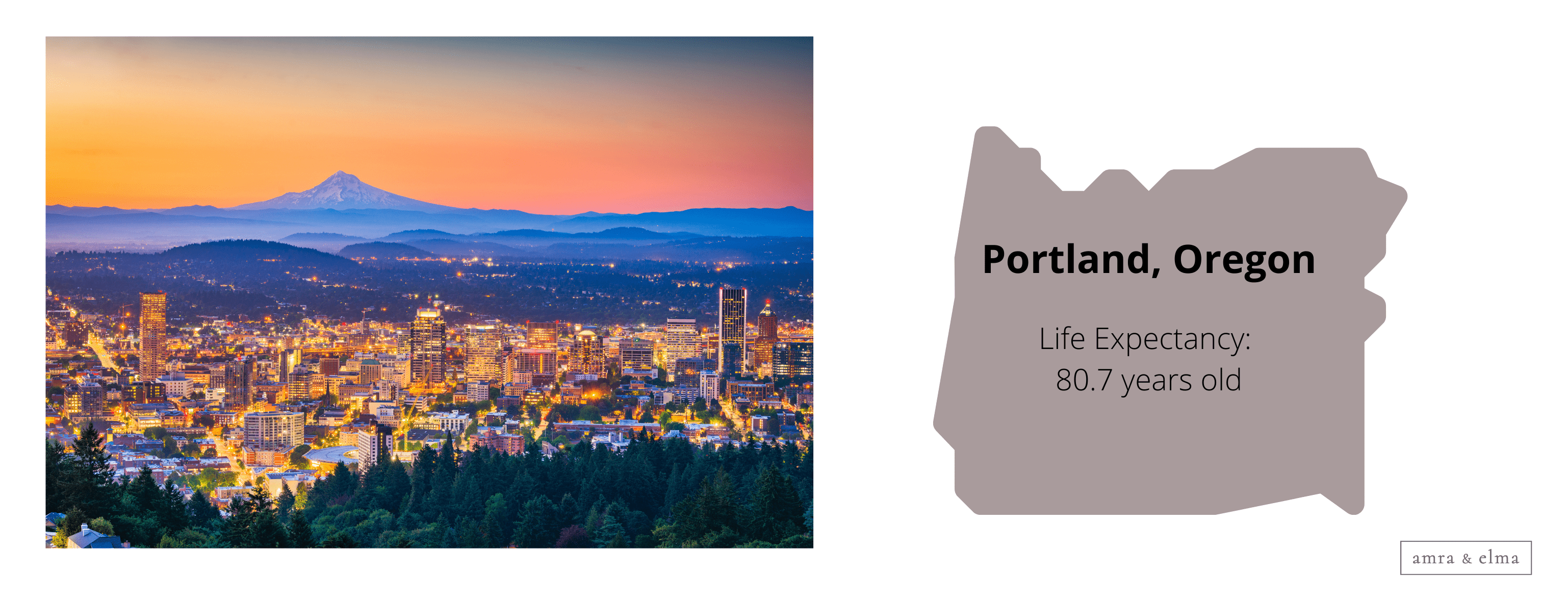
General Attributes of U.S. Cities with Longest Life Expectancies
Factors that may contribute to long lifespans include high concentration of parks, high socialization rates, easy access to hospitals and medial staff, access to good education and high paying jobs with good benefits, affordable living, and warm climate with high number of sunny days. Cities with longest life expectancies seem to have better than average a combination of these factors with Salem, Oregon leading the way with 85.9 years to other Oregon city coming in at the 10th position on our list with 80.7 years old.


